
Citizens, soldiers, and allies of the Roman Empire unite in Pandemic: Fall of Rome! Raise armies, defend your cities, and forge alliances to ward off the relentless incursions. Can you hold the line against the invading hordes and prevent the fall of Rome?
Pandemic: Fall of Rome is a cooperative game. The players all win or lose together.
Your goal is to ally with and/or eliminate each of the five invading barbarian tribes before the Roman Empire is overwhelmed. You and your teammates can lose in several different ways: if either Roma or too many other cities are sacked; if any tribes have overrun Roman territory; or if the Empire's resources have run dry.
Each player has a specific role with special abilities to improve the team's chances.
Solitaire rules provide additional options for a lone player, and after you're familiar with the game, you can use the included difficulty levels and the "Roma Caput Mundi" variant to make the game even more challenging.
Components
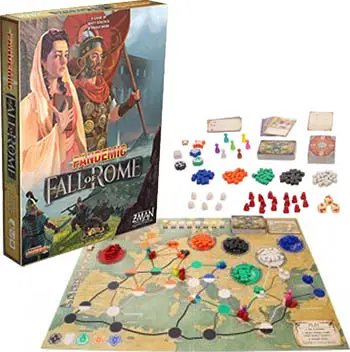
- 7 Pawns
- 7 Role Cards
- 70 Player Cards
- 5 Alliance Tokens
- 1 Invasion Rate Marker
- 1 Decline Marker
- 6 Forts
- 49 Barbarian Cards
- 7 Reference Cards
- 3 Battle Dice
- 100 Barbarian Cubes
- 16 Legions
- 1 Board
- Instructions
Setup
-
Prepare Board and Pieces
Place the board in the center of the table. Place 1 fort in Roma. Place the other 5 forts and the 3 battle dice near the board.
Place the legions in the circular legion supply space on the board. Place barbarians and alliance tokens in the circular barbarian supply spaces on the board matching their symbols and colors.
Place the Invasion Rate marker and Decline marker in the first spaces of their corresponding tracks.
-
Resolve Initial Invasion
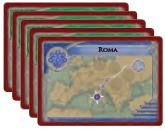
Take the 5 red-bordered Barbarian cards (each showing the city of Roma) from the Barbarian deck and place them faceup on the board in the Barbarian discard pile space (top right).
Take the 9 gold-bordered Barbarian cards and set them aside. Shuffle the remaining Barbarian cards and place them facedown on the board in the Barbarian deck space. Then shuffle the 9 gold-bordered cards and do the following with those cards:
- Flip over 3 cards and add 3 barbarians of the matching color to each city.
- Flip over 3 cards and add 2 matching barbarians to each city.
- Flip over 3 cards and add 1 matching barbarian to each city.
- Place these 9 cards faceup on top of the Roma cards in the Barbarian discard pile.
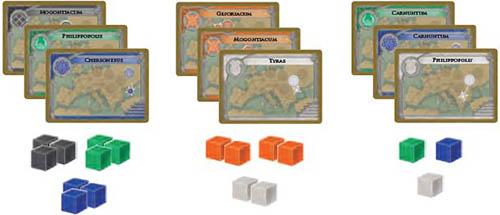
-
Prepare Player Components
Give 1 Reference card and 1 random Role card with its matching pawn (top left of the Role card) to each player. Return the remaining Reference cards, Role cards, and pawns to the box.
Separate the Player cards by type (City, Event, Revolt). Set aside Revolt cards. Randomly add a number of Event cards to the City cards based on the number of players. Shuffle these cards and deal a number of them faceup to each player to form starting hands.
# of players Events in Deck Starting Hand 2 4 4 3 5 3 4 6 2 5 8 2 If playing with the Vestalis role, shuffle and stack the remaining Event cards facedown to form an Event deck instead (see "Vestalis" on page 12). If not, return the remaining Event cards to the box.
Each player keeps their Player cards and Role card faceup on the table. Each player chooses one of their City cards and places their pawn and 2 legions from the supply in the matching city.
If a player does not have a City card (such as if all of their cards are Event cards), they may place their pawn (and legions) in any city on the board.
-
Prepare Player Deck
Choose the game's difficulty level by using 5, 6, or 7 Revolt cards, for an Introductory, Standard, or Heroic game, respectively. Return any remaining Revolt cards to the box.
Note: This is more than the typical number of Epidemic cards used in the original Pandemic!
Divide the remaining Player cards into facedown piles, as equal in size as you can, so that the number of piles matches the number of Revolt cards that you chose. Then shuffle 1 Revolt card into each pile facedown.
Stack these piles to form the Player deck, placing smaller piles on the bottom. Then place the Player deck facedown on the board in the Player deck space.
-
Begin Play
The players look at the City cards they have in their hand. The player with the City card whose city is farthest from Roma (highest number of days on the card) takes the first turn.
Game Play
Each player turn is divided into 3 steps:
- Do 4 Actions
- Draw 2 Player Cards (and resolve Revolts)
- Invade Cities
After doing the Invade Cities step, your turn ends. The player on your left takes the next turn.
Players should freely give each other advice, letting everyone offer opinions and ideas. However, the player whose turn it is decides what to do.
Your hand can have both City and Event cards in it. City cards are resources used to do some actions. Most Event cards can be played at any time, including during another player's turn.
I. Do 4 Actions
You can do up to 4 actions during your turn.
Select any combination of the actions listed below. You can do the same action several times during your turn, each time counting as 1 action.
Your role's special abilities may change how an action is done. Some actions involve discarding a card from your hand; all discards go to the Player discard pile.
March

Move your pawn to an adjacent city (connected by a single, uninterrupted line of any color, even across water). You may take up to 3 legions from your city with you. You cannot move into barbarian supply spaces.
Sail
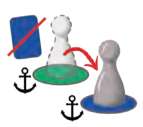
Discard a City card to move your pawn from a port city (a city with an anchor icon) to any other port city on the board.
The card's color must match a color of your destination. You may take up to 3 legions from your city with you.
Fortify

Discard a City card that matches your city to add a fort from the supply to your city. If all forts are in use, move a fort to your city from another city on the board. Each city can have up to 1 fort.
Recruit Army

Add legions from the supply to your city. The number of legions you place is equal to the recruitment rate (indicated by the Invasion Rate track on the board). There must be a fort in your city for you to do this action.
If there are not enough legions in the supply, place as many as possible, but do not move legions from elsewhere on the board.
Battle

Roll up to 1 battle die for each legion in your city (maximum 3 dice) and apply the results of your roll to your city. There must be at least 1 barbarian in your city for you to do this action.
 Remove 1 legion.
Remove 1 legion.
 Remove 1 barbarian (appears on 2 sides of the dice).
Remove 1 barbarian (appears on 2 sides of the dice).
 Remove 1 barbarian and 1 legion.
Remove 1 barbarian and 1 legion.
 Remove 2 barbarians and 1 legion.
Remove 2 barbarians and 1 legion.
 Resolve your role's special effect.
Resolve your role's special effect.
When you remove barbarians, you can choose to remove any combination of colors present in your city, but you must remove as many cubes as possible. Removed legions and barbarians are returned to their matching supplies.
Plot
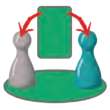
If there is another player in your city and you both agree to it, you can do one of the following:
Give a City card that matches your city to that player.
Take a City card that matches your city from that player.
If the player who gets the card now has more than 7 cards, that player must immediately discard a card (or play an Event card).
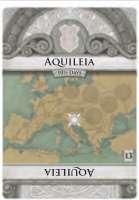
Plot example: Both Ophelia and Maxwell are in Aquileia. Ophelia is collecting white cards and Maxwell has the white Aquileia card. Ophelia asks Maxwell if she can take it from him.
Maxwell agrees, so Ophelia uses an action to take his card. Ophelia now has 8 cards, so she decides to play the Event "Mortui Non Mordent", removing 2 barbarians of the same color and bringing her hand down to 7 cards.
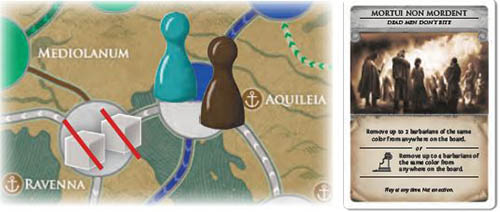
Forge Alliance
Discard the required set of cards of a tribe's color to forge an alliance between all players and that tribe. There must be at least 1 barbarian of that tribe in your city for you to do this action.
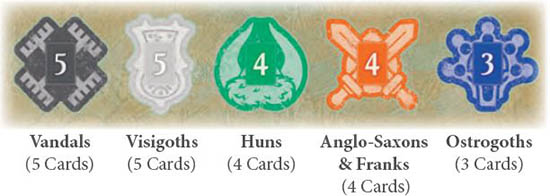
After forging an alliance, move the alliance token for the matching tribe onto its alliance space in the bottom-left corner of the board.
Allied barbarians continue to invade and can still be battled normally. Alliances are needed to win the game and to do the Enlist Barbarians action.
Enlist Barbarians
Discard a card matching an allied tribe's color to remove all the barbarians of that color from your city. Then add up to that many legions from the supply to your city.
If there are not enough legions in the supply, place as many as possible, but do not move legions from elsewhere on the board.
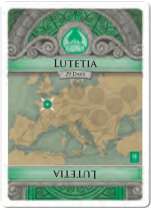
Enlist Barbarians Example: Ophelia is in Philippopolis with 1 legion and 3 green barbarians. Ophelia and her teammates made an alliance with the Huns on an earlier turn.
She discards a green card to Enlist Barbarians. She returns the 3 green cubes to the matching supply, replacing them with 3 legions.
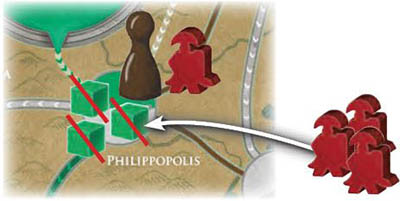
II. Draw 2 Player Cards
After doing 4 actions, draw the top 2 cards together from the Player deck.

When you are about to draw, if there are fewer than 2 cards left in the Player deck, the game ends immediately, and the players lose! (Do not reshuffle the discards to form a new deck).
Flip over, one at a time, as many Barbarian cards from the top of the Barbarian deck as the current invasion rate (indicated by the Invasion Rate track on the board). For each card flipped over, invade 1 city and discard the card to the Barbarian discard pile.
Revolts
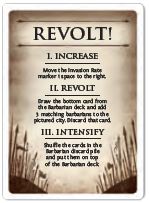
If your draw includes any Revolt cards, do the following steps:
-
Increase: Move the Invasion Rate marker 1 space to the right along its track.
-
Revolt: Draw the bottom card from the Barbarian deck and add 3 matching barbarians to the pictured city. Discard this card.
When adding cubes, if the city is defended by legions, the amount of cubes added is fewer. If the city is not defended and would have 4 or more cubes, fill the city to 3 cubes, then sack the city.
-
Intensify: Shuffle all cards in the Barbarian discard pile (including the one just drawn and any cards placed there during setup) and place them on top of the Barbarian deck.
Remember: When doing these steps, draw from the bottom of the Barbarian deck and shuffle only the cards in the Barbarian discard pile, placing them on top of the existing Barbarian deck.
It is rare but possible to draw 2 Revolt cards at once. In that case, do all three steps above once and then again.
The second time, the Barbarian card drawn for the Revolt step will be the only Barbarian card to "reshuffle", ending on top of the Barbarian deck. Event cards can be played after resolving the first Revolt card but before resolving the second one.
After resolving Revolt cards, return them to the box. Do not draw replacement cards for them.
Hand Limit
If you ever have more than 7 cards in hand (not counting any Revolt cards you may have drawn), discard cards or play Event cards until you have 7 cards in hand.
III. Invade Cities
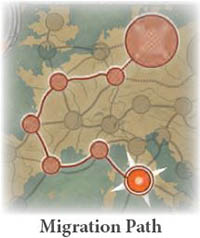
Each Barbarian card shows the color of the invading tribe, a pictured city, and a migration path.
A migration path is a line of cities that leads from the pictured city back to a barbarian supply space, shown on the card and on the board. In some cases (see below), barbarians cannot yet invade the pictured city and will instead invade a different city on the migration path.
Invading a City
To invade a city, add 1 cube to it from the matching barbarian supply unless that city is defended.
Barbarians have restrictions on the cities that they can invade. A city can be invaded only if at least one of the following applies:
The city already has one or more barbarians of that tribe.
The previous city on the migration path has one or more barbarians of that tribe.
When resolving an invasion from a Barbarian card, first check to see if the city pictured on the Barbarian card can be invaded.
Example: Ophelia flips over the black card for Lugdunum. There is already a black cube (Vandals) in that city, so she adds another black cube there.
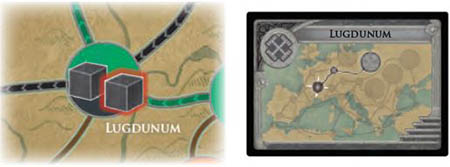
Ophelia flips over the black card for Tingi. There are no black cubes in Tingi yet, but there is a black cube in Corduba (the previous city on the migration path), so Tingi can still be invaded. She adds a black cube to Tingi.
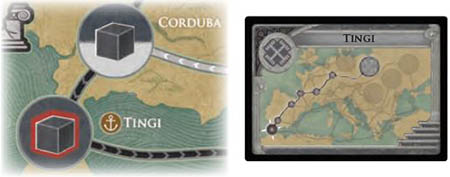
If the pictured city cannot be invaded, check the previous city on the migration path. If that city also cannot be invaded, continue to check each city, following the migration path backward until you find a city that can be invaded.
Example: Maxwell flips over the white card for Patrae, which cannot be invaded. He then checks Athenae, which also cannot. Continuing, he checks Constantinopolis, which can be invaded since there is a matching cube in Tyras, so he adds a cube to Constantinopolis
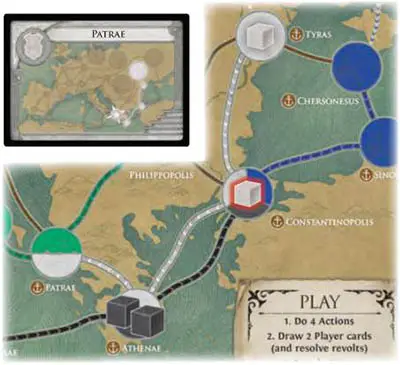
If you follow the migration path all the way back to the matching supply (without finding a city that can be invaded), the city on the migration path adjacent to that supply is invaded.
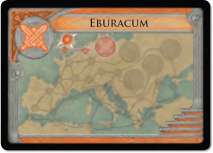
Example: Maxwell flips over the orange card for Eburacum. There is no orange cube (Anglo-Saxons) in Eburacum, Londinium, or Gesoriacum.
Since Gesoriacum is the city adjacent to the orange barbarian supply, Maxwell adds 1 orange cube to it.
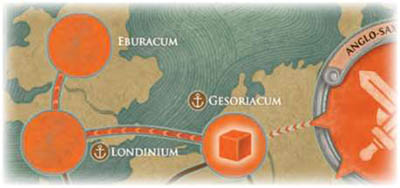
If a barbarian would be added to a city that has 3 barbarians of that color, do not place a fourth barbarian of that color. Instead, the city is sacked.
Defending a City
If a barbarian would be added to a city with one or more legions in it, those legions defend. Defending prevents the barbarian from being added but causes one or more of the legions to be removed from the city.
If the legions are supported by either a pawn or a fort, they are attacked. Remove one legion from the city, returning it to the supply.
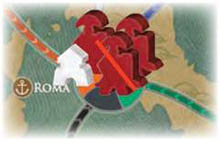
Examples: Maxwell would add a black cube to Carthago.
There are 2 legions in Carthago along with Ophelia's pawn, so instead of adding a black cube, Maxwell removes 1 legion.

Maxwell would add an orange cube to Roma. There are 3 legions in the city along with a fort, so Maxwell removes 1 legion instead of adding an orange cube.
If the legions are not supported by either a pawn or a fort, they are ambushed; remove all of the legions from the city, returning them to the supply.
Example: Maxwell would add a green cube to Philippopolis. There are 2 legions in the city and neither a pawn nor fort, so Maxwell removes both legions instead of adding a green cube.
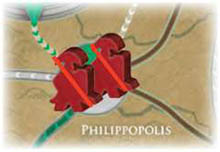
Note: When adding multiple cubes while resolving a Revolt card, add those cubes one at a time, resolving an attack or ambush as necessary for each cube.
Sacking Cities
If you would add a fourth barbarian of the same color to a city, the city is sacked instead. Move the Decline marker down 1 space on the Decline track.
If there is a fort in the city, return it to the supply, then add 1 barbarian from that tribe to each adjacent city (including those outside of the tribe's migration path). Legions defend against these added cubes.
If any of those cities already have 3 barbarians of that tribe, do not place a fourth cube into those cities. Instead, in each of them, chain reaction sacking occurs after resolving the sacking of the current city.
When chain reaction sacking occurs, first move the Decline marker down 1 space. Then add barbarians as above, but do not add a cube to a city that was already sacked (or chain reaction sacked) as part of resolving the current Barbarian card.
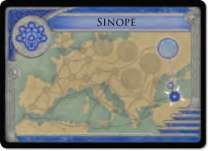
Example: Maxwell flips over the blue Sinope card. Since Sinope already has 3 blue cubes, Sinope is sacked! Maxwell moves the decline marker down 1 space.
He would add 1 cube to Constantinopolis, but Constantinopolis is defended; the legions there are ambushed, and both are removed (but no blue cube is added).
He would also add a cube to Chersonesus, but there are already 3 blue cubes there, so a chain reaction sacking occurs.
Maxwell moves the decline marker down 1 additional space and adds 1 blue cube to Tyras. Maxwell doesn't add a cube to Sinope (since it was already sacked because of this Barbarian card).
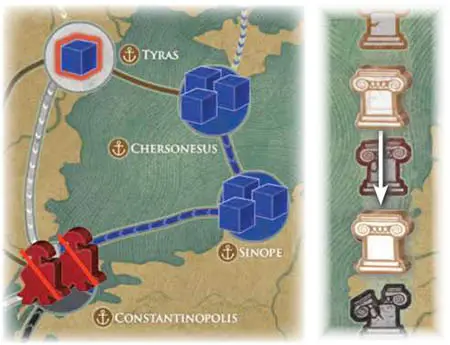

If the city of Roma is sacked, or if the Decline marker reaches the 8th space on the Decline track, the game ends immediately, and the players lose!
Turn End
After doing the Invade Cities step, your turn ends. The player on your left takes the next turn.
Event Cards
During any turn, any player may play an Event card. Playing an Event card is not an action. The player who plays the Event card decides how to use it.
Many Event cards present a standard option as well as a more powerful "corrupt" option that causes decline. If you choose to do the standard option, resolve the effect, then discard the card.
If you choose to do the corrupt option, move the Decline marker down 1 space, then resolve the effect and discard the card.
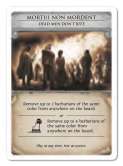
Example: Before the first card of the Invade Cities step is flipped over, Ophelia decides to play the "Mortui Non Mordent" Event card.
She decides to use the corrupt option: first she moves the decline marker down and then resolves the effect to remove two cubes each from Burdigala and Lugdunum.
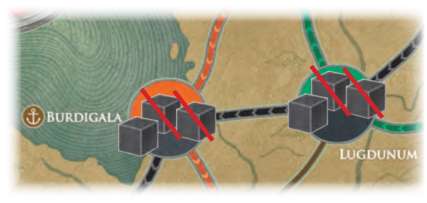
An Event card can be played at any time unless otherwise noted, except between drawing and resolving a card. After playing an Event card, discard it to the Player discard pile.
Player Cards
Place your cards faceup in front of you, for all players to see.
Only City and Event cards count toward your hand limit. Your Role and Reference cards and any Revolt cards you draw are not part of your hand.
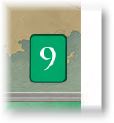
Note that an icon on each City card shows how many City cards of that color are in the Player deck (including the card itself).
Players may freely examine either discard pile at any time.
End of the Game
The players win as soon as all five barbarian tribes no longer threaten the Empire. For each tribe, this can happen in two ways:
- Players have forged an alliance with that tribe.
- There are no barbarians of that tribe in any cities on the board.

There are 4 ways for the game to end with players losing:
- When barbarian cubes would be added, you are unable to add the number of barbarians needed to the board.
- A player cannot draw 2 Player cards after doing their actions.
- The Decline marker reaches the 8th space on the Decline track.
- Roma is sacked.
Fine Points and Reminders
Remember to put the 5 red-bordered Roma cards in the Barbarian discard pile during setup. These cards are shuffled along with the other cards that are also in the Barbarian discard pile when the first Revolt card is drawn.
When invading a city, always check the pictured city first to see if that city can be invaded.
If it can, add 1 cube to that city. If not, follow the tribe's migration path backward from the pictured city to find the next city on the path that the tribe can invade. (Don't start at the beginning of the migration path and fill in the first gap).Do not add a barbarian to a city defended by 1 or more legions. If the city has legions in it (but no fort or player pawn) you must remove all the legions. If there is a fort or pawn, remove only 1 legion.
When a city is sacked, if there is a fort in that city, return it to the supply.
When barbarians are added to cities directly through Revolts or sacking, the restrictions for invasions (the city itself or the previous city having a matching barbarian) are ignored, but legions can still defend.
When a game effect refers to "your city", it is referring to the city that your pawn is currently in.
Challenges
Check here the information about the challenges.
Roles
Each player has a role with special abilities to improve your team's chances.
-
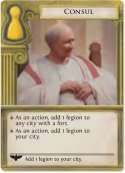
Consul
As an action, add 1 legion to any city with a fort. As an action, add 1 legion to your city.
 Add 1 legion to your city.
Add 1 legion to your city. -
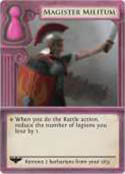
Magister Militum
When you do the Battle action, reduce the number of legions you lose by 1.
 Remove 2 barbarians from your city.
Remove 2 barbarians from your city. -
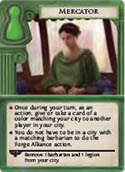
Mercator
Once during your turn, as an action, give or take a card of a color matching your city to another player in your city.
You do not have to be in a city with a matching barbarian to do the Forge Alliance action.
 Remove 1 barbarian and 1 legion from your city.
Remove 1 barbarian and 1 legion from your city. -
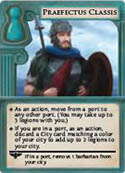
Praefectus Classis
As an action, move from a port to any other port. (You may take up to 3 legions with you).
If you are in a port, as an action, discard a City card matching a color of your city to add up to 2 legions to your city.
 If in a port, remove 1 barbarian from your city.
If in a port, remove 1 barbarian from your city. -
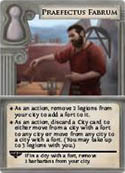
Praefectus Fabrum
As an action, remove 2 legions from your city to add a fort to it.
As an action, discard a City card to either move from a city with a fort to any city or move from any city to a city with a fort. (You may take up to 3 legions with you).
 If in a city with a fort, remove 2 barbarians from your city.
If in a city with a fort, remove 2 barbarians from your city. -
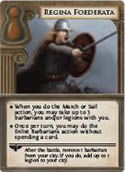
Regina Foederata
When you do the March or Sail action, you may take up to 3 barbarians and/or legions with you.
Note: You cannot cause a city to have more than 3 barbarians of a single color. Moving barbarians this way does not trigger city defense.
Once per turn, you may do the Enlist Barbarians action without spending a card. You must still have an alliance with that tribe in order to do this.
 After the battle, remove 1 barbarian from your city. If you do, add up to 1 legion to your city.
After the battle, remove 1 barbarian from your city. If you do, add up to 1 legion to your city. -
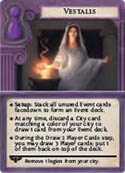
Vestalis
Setup: Stack all unused Event cards facedown to form an Event deck.
At any time, discard a City card matching a color of your city to draw 1 card from your Event deck.
During the Draw 2 Player Cards step, you may draw 3 Player cards; put 1 of them back on top of the deck.
 Remove 1 legion from your city.
Remove 1 legion from your city.
Continue Reading


